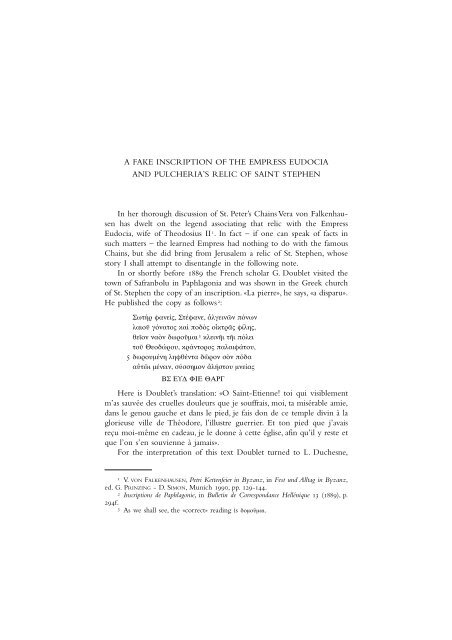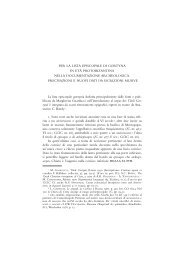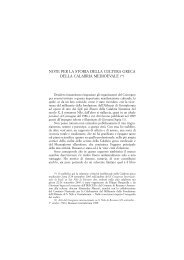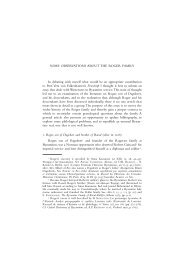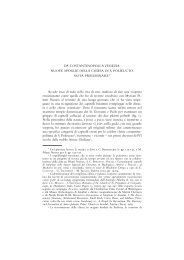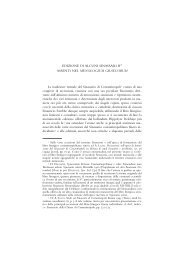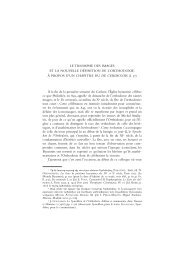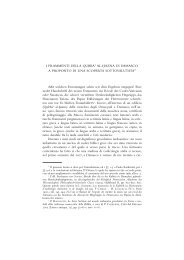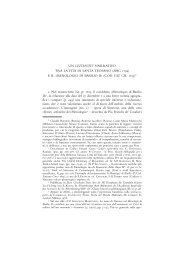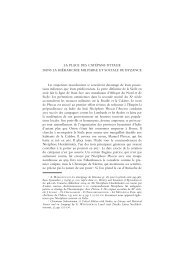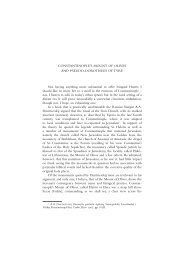Cyril Mango
Cyril Mango
Cyril Mango
You also want an ePaper? Increase the reach of your titles
YUMPU automatically turns print PDFs into web optimized ePapers that Google loves.
A FAKE INSCRIPTION OF THE EMPRESS EUDOCIA<br />
AND PULCHERIA’S RELIC OF SAINT STEPHEN<br />
In her thorough discussion of St. Peter’s Chains Vera von Falkenhausen<br />
has dwelt on the legend associating that relic with the Empress<br />
Eudocia, wife of Theodosius II 1 . In fact – if one can speak of facts in<br />
such matters – the learned Empress had nothing to do with the famous<br />
Chains, but she did bring from Jerusalem a relic of St. Stephen, whose<br />
story I shall attempt to disentangle in the following note.<br />
In or shortly before 1889 the French scholar G. Doublet visited the<br />
town of Safranbolu in Paphlagonia and was shown in the Greek church<br />
of St. Stephen the copy of an inscription. «La pierre», he says, «a disparu».<br />
He published the copy as follows 2 :<br />
Σωτρ φανες, Στέφανε, λγεινν πνων<br />
λαι γνατς κα πδς κτρς φίλης,<br />
θεν ναν δωρµαι 3 κλεινι τι πλει<br />
τ Θεδώρυ, κράντρς παλαιφάτυ,<br />
5 δωρυµένη ληφθέντα δρν σν πδα<br />
ατι µένειν, σσσηµν λήστυ µνείας<br />
ΒΣ Εϒ∆ ΦΙΕ ΘΑΡΓ<br />
Here is Doublet’s translation: «O Saint-Etienne! toi qui visiblement<br />
m’as sauvée des cruelles douleurs que je souffrais, moi, ta misérable amie,<br />
dans le genou gauche et dans le pied, je fais don de ce temple divin à la<br />
glorieuse ville de Théodore, l’illustre guerrier. Et ton pied que j’avais<br />
reçu moi-même en cadeau, je le donne à cette église, afin qu’il y reste et<br />
que l’on s’en souvienne à jamais».<br />
For the interpretation of this text Doublet turned to L. Duchesne,<br />
1 V. VON FALKENHAUSEN, Petri Kettenfeier in Byzanz, in Fest und Alltag in Byzanz,<br />
ed. G. PRINZING - D. SIMON, Munich 1990, pp.129-144.<br />
2 Inscriptions de Paphlagonie, in Bulletin de Correspondance Hellénique 13 (1889), p.<br />
294f. 3 As we shall see, the «correct» reading is δµµαι.<br />
23
24<br />
CYRIL MANGO<br />
who declared the last line suspect, especially the figure (date?) 515 and<br />
the Attic month Thargelion, but was satisfied with the rest of the inscription,<br />
which he ascribed to Eudocia, wife of Theodosius II. He also concluded<br />
that Safranbolu, being the city of Theodore, was the same as<br />
Euchaita, and if the latter was renamed Theodoroupolis only in the reign<br />
of John I Tzimiskes 4 , it may have been known earlier by that name on<br />
an unofficial basis.<br />
Once launched into print with Duchesne’s blessing, the Safranbolu<br />
inscription has enjoyed and continues to enjoy remarkable success. William<br />
Ramsay was greatly exercised by it and devoted several pages to<br />
demonstrating that Safranbolu could not have been Euchaita. The latter,<br />
he opined, was at Çorum (not quite right, but closer to the truth) 5 . The<br />
inscription was accepted by H. Leclercq 6 , H. Delehaye, who, however,<br />
explained that it did not refer to Euchaita 7 , F. Halkin 8 , D. Gorce in his<br />
edition of the Life of St. Melania 9 , E.D. Hunt 10 , K.G. Holum 11 , P. Maraval<br />
12 and, with complete assurance, by E. Livrea 13 . It is also, presumably,<br />
for the same reason that on the Classical Map of Asia Minor by W.M.<br />
CALDER and G.E. BEAN (London 1958) the site of Safranbolu is marked<br />
Germia Theodorias. Scholars who have expressed scepticism have been<br />
fewer: I can name only the obscure Gabrielides (see below), Chr. Marek<br />
14 , K. Belke 15 , R. Merkelbach and J. Stauber 16 . D. Feissel has prudently<br />
4 Actually, the name Theodoroupolis appears to have been given to Euchaina or<br />
Euchaneia (Çorum), often confused with Euchaita. See N. OIKONOMIDES, Le dédoublement<br />
de S.Théodore et les villes d’Euchaita et d’Euchaneia, in Analecta Bollandiana 104<br />
(1986), pp. 327-335.<br />
5 The Historical Geography of Asia Minor, London 1890, pp.21, 52-53, 319-322.<br />
6 Art. Eukhaita, in Dictionnaire d’Archéologie Chrétienne et de Liturgie, V/2, Paris<br />
1922, pp.704-705.<br />
7 Acta Sanctorum, Nov. IV (1925), p. 23.<br />
8 Inscriptions grecques relatives à l’hagiographie, in Analecta Bollandiana 71 (1953), p. 96.<br />
9 Vie de Sainte Mélanie, Paris 1962 (Sources Chrétiennes, 90), p. 246 n. 1.<br />
10 Holy Land Pilgrimage in the Later Roman Empire, AD 312-460, Oxford 1982,<br />
p. 233.<br />
11 Theodosian Empresses, Berkeley 1982, p.186 n. 52.<br />
12 Lieux saints et pèlerinages d’Orient, Paris 1985, p.368.<br />
13 La slogatura di Eudocia in un’iscrizione paflagone, in Zeitschrift für Papyrologie und<br />
Epigraphik 113 (1996), pp. 71-76.<br />
14 Stadt, Ära und Territorium in Pontus-Bithynia, Tübingen 1993 (Istanbuler Forschungen,<br />
39), p. 191 nr. 11: «Die Abschrift scheint mir verdachtig».<br />
15 Paphlagonien und Honorias,Vienna 1996 (Tabula Imperii Byzantini, 9), p. 268:<br />
Probably of the 19th century, but does it refer to the wife of Theodosius II or to<br />
Eudocia Makrembolitissa, wife of Constantine X and Romanus IV?<br />
16 Steinepigramme aus dem griechischen Osten, II, Munich 2001, p.308 nr. 10/<br />
02/99: Metrical faults too serious.
A FAKE INSCRIPTION OF THE EMPRESS EUDOCIA 25<br />
suspended judgment 17 .<br />
None of the above excellent scholars appears to have asked the obvious<br />
question: What was Eudocia doing at Safranbolu? Did she go there<br />
on holiday? Assuming she was in possession of an important relic of St.<br />
Stephen (in addition to the one, as we shall see, that she was to give to<br />
her sister-in-law Pulcheria), she must have been passing through those<br />
parts on her return journey from Jerusalem in 439. It is reasonable to<br />
assume that she would have followed the so-called «Pilgrim’s Road»,<br />
which cut diagonally across Asia Minor in the direction of Antioch.That<br />
road, however, was nowhere near Safranbolu 18 . We must assume, therefore,<br />
that on a whim she took a lengthy detour to visit an obscure locality<br />
(ancient name unknown) and, once there, built a church in honour<br />
of St. Stephen to which she donated her precious relic.<br />
Safranbolu, which has few, if any ancient remains, has not attracted<br />
much attention on the part of European travellers. A.D. Mordtmann,<br />
who visited it in 1856, says that it passed for («gilt für») medieval<br />
Theodoroupolis. It had a separate Greek «ghetto» called Granköi (read<br />
Kıranköy) of about 250 families with a church of St. Stephen, built in<br />
1805. He was shown there a relic of St. Stephen’s right (sic) foot, on<br />
whose authenticity he was unwilling to pass judgment. No word about<br />
an inscription 19 . The Greek settlement multiplied – it is said to have<br />
numbered 3,000 before the exchange of populations in 1922 – and in<br />
1871 built a much bigger church of St. Stephen with a dome and two<br />
bell-towers. It must have been the new church that Doublet visited. He<br />
failed, however, to see in it another inscription – a genuine epitaph, that<br />
was probably brought in from the surrounding countryside 20 . Eventually<br />
St. Stephen’s was turned into a mosque, which is still standing minus the<br />
bell-towers, and on either side of the central door is our Eudocia<br />
inscription, carved twice in neat 19th-century characters, in capital letters<br />
on the left and lower case on the right (Pl. 1-2) 21 . It differs from<br />
17 Bulletin épigraphique, 1998, No.659 = Revue des études grecques 111 (1998),<br />
p. 711.<br />
18 See D. FRENCH, Roman Roads and Milestones of Asia Minor, Fasc. 1: The Pilgrim’s<br />
Road, Oxford 1981 (BAR Internat. Series, 105), map 4 (Zonguldak sheet).<br />
19 A.D. MORDTMANN d. Ä., Anatolien. Skizzen und Reisebriefe aus Kleinasien<br />
(1850-1859), ed. F. BABINGER, Hannover 1925, p.253f.<br />
20 Published by E. LEGRAND, Inscriptions de Paphlagonie, in Bulletin de Correspondance<br />
Hellénique 21 (1897), p. 92.<br />
21 For the photographs reproduced here, taken by Ms. Vildan Gök, I am very<br />
grateful to Dr. M.I. Tunay. Poor photo in Chr. KYRIAKOPOULOS, Σαφράνπλη -
A FAKE INSCRIPTION OF THE EMPRESS EUDOCIA 27<br />
Doublet’s copy in having δµµαι instead of δωρµαι in line 3 and<br />
ΘΑΡ.Η instead of ΘΑΡΓ in the last line, conveniently glossed into Karamanlidika:<br />
πς γι νπς σενεσιντέ, πριλτ η («In the year 515, April 8»).<br />
I do not know why Thargelion (May/June) was thought to be April.<br />
One does not have to be an expert in Late Antique poetry to see<br />
that the Eudocia inscription belongs, not to the world of the 5th century<br />
22 , but to that of 19th-century ellinismos. It is in «Byzantine» dodecasyllables<br />
with little regard for the quantity of vowels and starts with a<br />
nominative absolute (φανείς), i.e. Stephen, followed by the first-person<br />
δµµαι, i.e. Eudocia.These incongruities were pointed out long ago by<br />
one A. Gabrielides, who ascribed the poem to a «half-educated schoolmaster»<br />
(µιµαθς διδάσκαλς) 23 . Attention should also be drawn to the<br />
rare word κράντωρ (line 4), which Doublet was mistaken to translate<br />
«guerrier» and Livrea as «eroe», «santo». Κράντωρ means «ruler», princeps<br />
or effector (as in the epigram quoted by Pausanias, 8.52.3), and is correctly<br />
defined in what was probably the standard Greek dictionary for Greeks<br />
that the «half-educated schoolmaster» might have consulted 24 . In other<br />
words, he described Theodore as a ruler, not as a warrior saint. The<br />
remarks of the worthy Gabrielides may throw some light on this little<br />
puzzle. After saying that in his day Safranbolu was called Theodoroupolis,<br />
he adds that he did not know who the Theodore in question was. An<br />
old schoolmaster (a different one?) told him the following story. The<br />
Empress Eudocia, wife of Theodosius, fell ill and proceeded to that town<br />
for a change of air in the year 515 (sic). There she got better and attributed<br />
her cure to the left foot of St. Stephen, which she had brought with<br />
her. She made a gift of the relic to the town, whose governor was called<br />
Theodore. Gabrielides adds that the relic was still preserved and extended<br />
from the left knee to the tip of the foot – quite a sizeable assemblage<br />
of bones. In other words, the inscription reflected the local legend<br />
as it was told in the 19th century and the nature of the relic that was<br />
kept there at the time.<br />
∆άδυρα (sic), 2nd ed., Thessaloniki 1988, fig. 6 on p. 201. For the Eudocia inscription,<br />
ibid., pp. 88, 101 and fig. 7 on p. 202. I am indebted to Dr.Vasso Pennas for a<br />
copy of this somewhat incoherent publication.<br />
22 The contrast with the genuine hexameter inscription of Eudocia in the baths<br />
of Gadara (Suppl. epigr. gr. 32, No.1502) could hardly be more striking.<br />
23 Περ τς παρίας Νεκαισαρείας, in ενφάνης 1 (1896), pp. 132-133. I am indebted<br />
to D. Feissel for bringing this scarce publication to my attention.<br />
24 Λεικν τς λληνικς γλώσσης πίτµν, ed. K. GARPOLAS, Athens 1839.
28<br />
CYRIL MANGO<br />
There remains a curious coincidence that has not gone unnoticed.<br />
Eudocia did dislocate her foot during her first visit to Jerusalem (438-<br />
439) and was allegedly healed by the prayers of St. Melania offered in<br />
front of certain unspecified relics.The story is told in the original Life of<br />
Melania 25 , whose Greek text was first published in 1903, and so could<br />
not have been known to the author of the Safranbolu inscription. He<br />
might, however, have been aware of the Metaphrastic version, which<br />
repeats the same tale 26 . No source known to me specifies that Eudocia<br />
injured her left knee and foot.<br />
After eliminating from the dossier the inscription of Safranbolu, we<br />
may consider a related incident that has to do with St. Stephen’s relics,<br />
this time at Constantinople. First, however, we may set down certain<br />
facts that appear to be reasonably well established:<br />
December 415: St. Stephen’s relics are found at Kapher-Gamala near<br />
Jerusalem and are temporarily deposited in the Sion church. News of the<br />
discovery echoes throughout the Christian world and some dispersion of<br />
small fragments, notably to the West, immediately takes place 27 .<br />
c. 416: Aurelian, Praetorian Prefect of the East, 399, 414-416 (i.e. at the<br />
very time of the invention) builds a church in honour of the Saint on<br />
his estate at Constantinople in the expectation of obtaining some of the<br />
relics, but his wish is not satisfied, which is rather odd, considering his<br />
influential position 28 .<br />
439: At Jerusalem a martyrium of St. Stephen outside the north gate<br />
of the city, built either by Eudocia or bishop Juvenal (or both) is dedicated<br />
on 15 May. The Saint’s remains (presumably the major part of<br />
them) are deposited there 29 . On returning to Constantinople the same<br />
year, Eudocia gives her sister-in-law Pulcheria a relic of St. Stephen<br />
(body part unspecified), which is laid in Pulcheria’s basilica of St. Laurence<br />
at Blachernai 30 .<br />
25 Ed. GORCE, cit., p. 244.<br />
26 PG 116, col. 788: Τν γρ πδα τς ασιλίδς πηρεία δαίµνς τν ρµνίαν<br />
παρατραπέντα κείνη [Melania]… ε µνη πρς τ εθς πανήγαγε.<br />
27 See S. VANDERLINDEN, Revelatio sancti Stephani, in Revue des études byzantines 4<br />
(1946), pp. 178-217.<br />
28 See A. CAMERON - J. LONG, Barbarians and Politics at the Court of Arcadius,<br />
Berkeley 1993, p.74. The source (Vita Isaacii) is relatively late, but appears credible.<br />
29 See, e.g., E. HONIGMANN, Juvenal of Jerusalem, in Dumbarton Oaks Papers 5<br />
(1950), pp. 225-227.<br />
30 MARCELLINUS COMES, Chronicon, s.a. B. Croke’s comment on this passage in<br />
The Chronicle of Marcellinus, Sydney 1995, p.83 is somewhat confused.
A FAKE INSCRIPTION OF THE EMPRESS EUDOCIA 29<br />
Mid-9th century or earlier 31 :The cult centre of St. Stephen at Constantinople,<br />
including his relics, has shifted to the district of Constanti(ni)anae.<br />
The problem I should like to examine is whether there occurred a<br />
translation to Constantinople of a major relic of St. Stephen, namely his<br />
right arm or hand, as early as 427/428 (or possibly 421). The only authority<br />
for such a translation is the Chronicle of Theophanes, which<br />
under AM 5920 (= AD 427/428) relates the following story. In return for<br />
a large sum of money and a gold jewelled cross to be erected on the site<br />
of Calvary, the archbishop of Jerusalem (unnamed, but given as Praylius<br />
in the rubric) sent to Constantinople Stephen’s right είρ (let us call it<br />
arm).The relic was conveyed to Constantinople by the holy man Passarion<br />
32 . Pulcheria, apprised in a vision, went out to meet it and built a<br />
wonderful church (κν νδν) in the Imperial Palace wherein she<br />
deposited it 33 .<br />
The date 427/428 is certainly not to be taken very seriously. Theophanes’<br />
chronology for the relevant period is hopelessly muddled: he<br />
places the invention at Kapher-Gamala in 426/427 instead of the correct<br />
415 and is completely mixed up about the succession of Jerusalem’s bishops.<br />
Having no other material for AM 5920, he may simply have inserted<br />
there the story of the relic’s adventus, which he derived, perhaps, from a<br />
hagiographic source. A. Frolow arbitrarily changed the date to 420 34 ,<br />
whereas K. Holum, for reasons of his own, has argued vigorously that the<br />
incident occurred, not in 427/428 (the 20th year of Theodosius II counting<br />
from his accession in 408), but in 421 (the 20th year from his proclamation<br />
as Augustus on 10 January 402) 35 .<br />
There can be no doubt that a chapel of St. Stephen did exist in the<br />
Imperial Palace, more precisely in the part of the palace called Daphne.<br />
It is attested in the reign of Zeno (474-491) when it received a copy of<br />
31 Seeing that the supremely silly translatio to Constanti(ni)anae was rendered<br />
into Latin by Anastasius Bibliothecarius. Text in PL 41, col. 817f.<br />
32 Passarion died in extreme old age in Oct./Nov. 428: CYRIL OF SCYTHOPOLIS,<br />
Vita Euthymii, ed. E. SCHWARTZ, Leipzig 1939 (Texte und Untersuchungen zur<br />
Geschichte der altchristlichen Literatur, 49/2), pp. 26-27.<br />
33 Ed. C. DE BOOR, pp.86-87; repeated by CEDRENUS, Bonn ed., I, p. 592.<br />
34 Numismatique byzantine et archéologie des Lieux Saints, in Mémorial Louis Petit,<br />
Bucarest 1948, p.84.<br />
35 Pulcheria’s Crusade, AD 421-22, in Greek, Roman and Byzantine Studies 18<br />
(1977), p. 163. See further K.G. HOLUM - G. VIKAN, The Trier Ivory, in Dumbarton<br />
Oaks Papers 33 (1979), esp. p. 127f.
30<br />
CYRIL MANGO<br />
St. Matthew’s Gospel written in the hand of Barnabas that had been<br />
found in Cyprus 36 , an incident dated by Victor Tunnunensis to 488 37 .<br />
From the reign of Heraclius onwards the chapel in question is repeatedly<br />
mentioned as a venue for imperial coronations and weddings 38 and it<br />
figures prominently in the Book of Ceremonies 39 . There is, however, no<br />
independent confirmation that it had been built by Pulcheria. That, it<br />
may be thought, is not too serious an objection, but what is odd is that<br />
the famous dexia plays no part whatever in imperial ceremonial 40 , indeed<br />
is never alluded to, unless I am mistaken, until the 12th century, when it<br />
appears, along with a multitude of other relics, in the capella imperatoris,<br />
i.e. St. Mary of the Pharos 41 . That being so, I am a little surprised that<br />
Ioli Kalavrezou should describe St. Stephen’s arm as «enriching imperial<br />
ceremonial and strengthening the position of the emperor» 42 .<br />
Furthermore, the very translation as described by Theophanes finds<br />
no corroboration in other sources (for Proclus see below).This has been<br />
shown at length by J. Wortley 43 , to whose demonstration we may add<br />
one further text, namely the 9th-century 44 Brussels Chronicle, which<br />
devotes particular attention to the arrival of saints’ relics at Constantinople.<br />
For the reign of Theodosius II it records only that «the relics of the<br />
36 THEODORUS ANAGNOSTES, Kirchengeschichte, ed. G.C. HANSEN, Berlin 1971 (Die<br />
griechischen christlichen Schriftsteller der ersten Jahrhunderte, 54), p. 121, Nr.436.<br />
Cf. CEDRENUS, I,p.619; ALEXANDER MONACHUS, Laudatio Barnabae, ed. P. VAN DEUN,<br />
Turnhout-Leuven 1993 (Corpus Christianorum. Series Graeca, 26), p. 118 (in the<br />
chapel of the palace).<br />
37 Monumenta Germaniae Historica, Auct. ant., XI,p.191.<br />
38 THEOPHANES, ed. DE BOOR, pp.299, 300, 769; CONSTANTINUS PORPHYROGE-<br />
NITUS, De Cerimoniis, Bonn ed., I, pp. 196-197, 208, 212, 628.<br />
39 See J. EBERSOLT, Le Grand Palais de Constantinople, Paris 1910, pp.52-53.<br />
40 The contents of St. Stephen’s chapel, listed in De Cerimoniis,p.640, were limited<br />
to «the great cross of St. Constantine», three sceptres and a few other objects of<br />
secular ceremonial.<br />
41 P. RIANT, Exuviae sacrae Constantinopolitanae, Geneva 1877, II, pp. 211-212,but<br />
absent from the comprehensive listing by ANTONY OF NOVGOROD, Kniga Palomnik,<br />
ed. Chr. LOPAREV, Pravoslavnyj Palestinskij Sbornik 51 (1899), pp. 18-19.<br />
42 Helping Hands for the Empire, in Byzantine Court Culture from 829 to 1204, ed.<br />
H. MAGUIRE, Washington, DC 1997, p.66.<br />
43 The Trier Ivory Reconsidered, in Greek, Roman and Byzantine Studies 21 (1980),<br />
pp. 381-394.<br />
44 It is usually dated to the 11th century, but its final part is a bare list of emperors<br />
from Basil I to Romanus III, no doubt added by a later copyist.The fact that the<br />
Brussels Chronicle is the only Byzantine text to give the exact date of the first<br />
Russian attack on Constantinople (860) strongly suggests that it was compiled soon<br />
after that event.
A FAKE INSCRIPTION OF THE EMPRESS EUDOCIA 31<br />
holy martyrs Stephen, Laurence and Agnes were deposited in the martyrion<br />
of St. Laurence» 45 .The same information is repeated in a contaminated<br />
manuscript of the Epitome of Theodorus Anagnostes, which adds<br />
that the deposition took place on a 21 September, κα τελεται µέρι σήµερν<br />
κεσε τ ατ µέρα µνήµη ατν 46 .The commemoration of 21 September<br />
has not survived in our liturgical sources of the 9th-10th centuries<br />
(Typicon of the Great Church, Synaxarion), which suggests that it<br />
may have been of earlier date and had fallen into desuetude.<br />
Theophanes, as we have seen, describes the despatch of St. Stephen’s<br />
arm as a thanksoffering for the gold jewelled cross of Golgotha. This<br />
piece of information has been taken at face value and connected with<br />
the introduction of a new design on the reverse of gold coins, namely<br />
that of a victory holding a long jewelled cross, which can be dated to<br />
420 or 422 47 . Whether the long cross was meant to refer to that of Golgotha<br />
I am unable to say, but there is a serious objection to this rapprochement:<br />
the monumental jewelled cross erected on the rock of Golgotha is<br />
prominently displayed in the famous apse mosaic of S. Pudenziana, dated<br />
by art-historians to the 390’s 48 . Frolow, who was aware of the difficulty,<br />
buried it in a footnote in which he boldly stated that the mosaic, or at<br />
any rate its central part, cannot belong to the pontificate of Siricius (384-<br />
399) or even to its restoration (?) in the early 5th century, but should be<br />
ascribed to Hadrian I (772-795) 49 – a most unlikely view. We are faced<br />
with a clear choice: either the mosaic is later than 420 or the story of<br />
Theophanes is false.<br />
An edifice of speculation based on the sermons of Proclus (bishop of<br />
Cyzicus resident at Constantinople, 426-434, then Patriarch of Constantinople,<br />
434-446) has been constructed by F. J. Leroy on the assumption<br />
45 F. CUMONT, Anecdota Bruxellensia, I:Chroniques byzantines du MS 11376, Gand<br />
1894, p.21.<br />
46 PG 86/1, col. 216A. The passage in question has been excluded from<br />
Hansen’s ed. He does not state his reasons for doing so. The text in PG goes back<br />
to cod. Paris. gr. 1440, s. XVI.<br />
47 This issue is dated by the legend VOT XX MVLT XXX. Strictly speaking,<br />
the vicennalia of Theodosius should have fallen in 422, but his 15th anniversary was<br />
celebrated in 415 and his 30th in 430. Discussion by Ph. GRIERSON - M. MAYS, Catalogue<br />
of Late Roman Coins in the Dumbarton Oaks Collection, Washington, DC 1992,<br />
pp. 142-143, with a preference for 420.<br />
48 For the dating evidence see G. MATTHIAE, Mosaici medioevali delle chiese di<br />
Roma, Rome 1967, pp.68-69.<br />
49 Numismatique, cit., p. 86, n.4.
32<br />
CYRIL MANGO<br />
that Theophanes’ account was true 50 . He alleges that Proclus’ Homily 12<br />
(on the Resurrection) was delivered in the chapel of St. Stephen built by<br />
Pulcheria («en quelque sorte paroisse impériale») and contains a precise<br />
reference to the mosaics that decorated it; that the Laudation of St.<br />
Stephen (Homily 17) was spoken upon the translation of his relic to<br />
Constantinople (thus excluding a date in 421) or its first anniversary; and<br />
that two sermons wrongly attributed to John Chrysostom, namely PG<br />
62, coll. 933-934 (on St. Stephen) and PG 50, coll. 715-720 (In proditionem<br />
Iudae) are also by Proclus and belong to the same group. Of the four<br />
texts in question we may eliminate Homily 17, which says nothing specific,<br />
and In proditionem Iudae, which manifestly refers to Daphne, the<br />
suburb of Antioch, not the Daphne palace at Constantinople 51 . Homily<br />
12 and the short piece PG 63, coll. 933-934 do allude to the «virgin<br />
Empress», i.e. Pulcheria, in vague terms.The former, which contains only<br />
a fleeting reference to Stephen, lauds the Empress’s liberality (to new<br />
baptizands?) and, incidentally, says nothing about mosaics 52 . The passage<br />
that has been interpreted as pointing to St. Stephen’s palace chapel and<br />
the relic kept in it occurs in PG 63, coll. 933-934 53 . Stephen, we are told<br />
here, fought the Jews when he was alive; now that he is dead, he is<br />
taking up arms against heretics (Nestorians?).The prize he received then<br />
was similar to the one he is receiving now: «Stephen is in the palace, for<br />
the Empress, who is a virgin, has stored him in her chamber [or in her<br />
heart?]. Stephen is among magistrates, for he has made the Emperor’s<br />
father the son of a man who has shown hospitality to strangers. Stephen<br />
is in charity towards the poor, for he has become the bountiful and<br />
faithful provider of widows and orphans» (ν ασιλείις Στέφανς θαλά-<br />
µευσε γρ ατν ασιλς κα παρθένς παρ ρυσι Στέφανς τν γρ τ<br />
ενδήσαντς παδα ασιλέως πεπίηκε πατέρα ν φιλπτωία Στέφανς<br />
ηρν κα ρφανν πλσις γέγνε κα πιστς κνµς). Proclus (if it is<br />
he) does appear to be alluding to certain contemporary cirumstances,<br />
while representing Stephen as the champion of the poor, presumably for<br />
50 L’homilétique de Proclus de Constantinople, Città del Vaticano 1967 (Studi e testi,<br />
247), esp. p. 158.<br />
51 It speaks of springs of water, groves of trees and the «Pythian demon» taking<br />
fright at the Cross: PG 50, coll. 715-716.<br />
52 Unless Leroy had in mind the sentence, PG 65, col. 788B, τν πίγειν ρανν<br />
τν ρώµενν καλλώπισεν, whatever exactly that may mean.<br />
53 HOLUM, Theodosian Empresses, cit., p. 104, n.116, uses this passage as his argument<br />
massue to refute Wortley’s criticism (as in n. 43 supra).
A FAKE INSCRIPTION OF THE EMPRESS EUDOCIA 33<br />
having been one of the seven chosen to minister to widows (Acts, 6.<br />
1-5). For the emperor’s father the obvious candidate is the Persian<br />
eunuch Antiochus, who acted as guardian of Theodosius II 54 , but we do<br />
not happen to know whose son he was. The last sentence may refer to<br />
the setting up of a charitable institution bearing St. Stephen’s name. But<br />
what are we to make of the statement that Pulcheria «housed» (θαλάµευσε)<br />
Stephen? Is it to be taken literally and, if so, does it necessarily<br />
imply that she had deposited Stephen’s relic in the Imperial Palace rather<br />
than in her church of St. Laurence built on her estate of Pulcherianae,<br />
or should it be understood metaphorically? A parallel is provided by<br />
Homily 12, PG 65, col. 788B: «She has mortified her own flesh against<br />
the passions; she has housed (θαλάµευσεν) the crucified One in her<br />
spirit». Here, certainly, the meaning is metaphorical.<br />
To conclude this part of our discussion, I can see no firm grounds to<br />
give credence to Theophanes’ story and several reasons for disbelieving<br />
it. The only well-attested relic of St. Stephen in 5th-century Constantinople<br />
is the one that was brought by Eudocia in 439. The conjunction<br />
of Stephen and Laurence was not, of course, fortuitous.The two deaconmartyrs<br />
were often thought as a pair and were represented side by side<br />
in mural paintings. Their remains were allegedly laid in the same tomb<br />
in the Pelagian basilica of S. Lorenzo fuori le mura, and there is a text of<br />
uncertain date concerning the «coniunctio corporum... Stephani et Laurentii<br />
facta Romae sub Theodosio iuniore» 55 . Seeing that Eudocia exercised,<br />
so to speak, patronal rights over St. Stephen’s bones, one can readily<br />
see why Pulcheria, who was not exactly on friendly terms with her,<br />
might have wished to establish a prior claim on the Protomartyr – hence<br />
the invention of the story related by Theophanes.<br />
For some time Stephen’s relics remained at St. Laurence’s. In speaking<br />
of them, Marcellinus Comes uses the present tense, «in basilica sancti<br />
Laurentii positae venerantur». His Chronicle, as it survives today, extended<br />
to 534 56 . There is also a neglected reference in the Miracles of Sts.<br />
54 The chronology of Antiochus’ career is uncertain. According to J.R. MARTIN-<br />
DALE, Prosopography of the Later Roman Empire, II, Cambridge 1980,p.102, he was dismissed<br />
by Theodosius II in or shortly after 421. J. Bardill argues, however, that he<br />
remained in service until 439:in G.GREATREX - J. BARDILL, Antiochus the Praepositus,<br />
in Dumbarton Oaks Papers 50 (1996), p. 197.<br />
55 Acta Sanctorum, Aug. II (1735), pp. 528-530.<br />
56 It is, of course, possible that in this passage he neglected to update the first<br />
edition of 518.
34<br />
CYRIL MANGO<br />
Cosmas and Damian (6th century?).The story concerns a Syrian woman<br />
called Martha who, while a patient in the miraculous shrine, was subjected<br />
to lesbian advances from one Christina, who was possessed by a<br />
demon.The Saints appeared to Martha in a vision, bidding her not only<br />
to avoid Christina, but to go home «for the sake of our brother St.<br />
Stephen, for she happened to be the wife of a cleric of St. Laurence’s» 57 .<br />
A synaxis of St. Stephen in St. Laurence’s on Wednesday of Easter week<br />
is recorded in the 9th/10th-century Typicon of the Great Church 58 .By<br />
that time, however, the cult of St. Stephen had migrated to his church at<br />
Constanti(ni)anae, which became the venue of his synaxeis of 27 Dec.<br />
(martyrdom), 2 Aug. (translation) and 15 or 16 Sept. (invention). Following<br />
a suggestion by J. Pargoire 59 , this move has been attributed to the<br />
initiative of the princess Anicia Juliana (d. 527/528). That has often been<br />
stated as a fact, but is only a supposition, which may or may not be<br />
right. I shall not discuss the matter here so as to spare the honorand a<br />
great deal of tedium without the prospect of a clear solution.<br />
CYRIL MANGO<br />
57 L. DEUBNER, Kosmas und Damian, Leipzig-Berlin 1907, p.131.<br />
58 Ed. J. MATEOS, Le Typicon de la Grande Église, Roma 1962 (Orientalia Christiana<br />
Analecta, 165), II, p. 102.<br />
59 À propos de Boradion, in Byzantinische Zeitschrift 12 (1903), pp. 488-490.
Pl. 1<br />
Pl. 2


